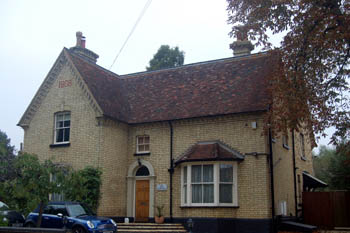The White Horse Public House Flitton

The Old White Horse, October 2010
The White Horse Public House: 29 High Street, Flitton
There are only references to two public houses in the village of Flitton: the White Horse and the White Hart. The earliest mention of a White Horse is in a countywide licensing register of 1822 [ref: CLP13].
In 1834 the estate of brewers Robert Lindsell and William Hogg of Biggleswade was conveyed to Frederick Hogg of Girtford and William Lindsell of Huntingdon [eef: GK0/1]. The public houses included the White Horse which was described as abutting south onto the street.
Directories for Bedfordshire were published every few years during the 19th century. The White Horse is mentioned in directories of 1839, 1847 and 1850 but is absent from those of 1854, 1862 and 1864.
The current White Horse was built in 1868. It was owned by Biggleswade brewers Wells & Company as the firm owned by Hogg and Lindsell had become known. It seems likely, therefore, that it was built on the site of the early 19th century pub.
A directory of 1869 reveals that the White Horse was tenanted by a William Palmer. In the directories of 1854, 1862 and 1864 William Palmer is listed as a beer retailer and market gardener. This strongly suggests that in those years the White Horse had ceased to be a fully licensed public house and become a beerhouse; beerhouses are not listed by name in directories in the way that public houses are. Clearly, however, the newly built establishment was a public house from the first.
In 1899 Wells and Company was bought by Kent businessman George Winch for his son Edward Bluett Winch. The new firm was called Wells & Winch Limited. The countywide licensing register of 1901 notes for the White Horse: "repair fairly good and clean", it had both a front and a back door.
The Rating and Valuation Act 1925 specified that every building and piece of land in the country was to be assessed to determine its rateable value. The valuer visiting the White Horse [ref: DV1/C270/43] notes that the tenant Edward Francis Smith paid £12/10/- per annum to Wells and Winch, the same as pre-war rent. He noted: "Built 1868" and "Nice looking place, kept clean".
Accommodation comprised a kitchen, a living room, an underground cellar ("no pulls"), a "fair" bar parlour, and a "fair" tap room. The valuer considered the tied rent was also fair! Trade was one barrel of beer per week, eight dozen bottles of beer per week, a "small" tobacco trade, and one to one and a half bottles of spirits per week. Takings were roughly £250 per annum. Outside stood a wood and corrugated iron blacksmith's shop measuring 25 feet by 12 feet and two loose boxes. The tenant also leased 2.267 acres of "wet" grassland for £4/15/- per annum.
The former public house is now a private house. Bedfordshire Archives has a licensing register covering the years 1934 to 1959 [ref: PSA5/2] and a register covering the years 1965 to 1995 [ref: PSA5/5]. The White Horse is included in the first register but not the second indicating that it closed between 1959 and 1968. Wells & Winch was bought by Suffolk brewers Greene King in 1961.
Licensees: Note that this is not a complete list; italics indicate licensees whose beginning and/or end dates are not known
- 1822: John Wright;
- 1823-1828: David Day;
- 1839: William Bigg;
- 1847: John Abbis;
- 1850: Joseph Abbis;
- 1854: none;
- 1862: none;
- 1864: none;
- 1869-1892: William Palmer (& market gardener);
- 1892-1894: Alexander Samuel Stevens;
- 1894-1896: Benjamin Douch;
- 1896: Frederick Lawson;
- 1896-1898: George Davis;
- 1898-1899: Edwin Fowle;
- 1899-1901: William Crutcher;
- 1901-1903: Arthur William Hawtin;
- 1903-1925: Edward Francis Smith;
- 1925-1927: Henry Joseph Draimer;
- 1927-1954: George William Anstee;
- 1954-1955: Clyde William McDaniel;
- 1955-1956: Douglas Hedges
- 1956: William Harry Brooks
- 1956-1958: Lewis Benson
- 1958: William Harry Brooks
- 1958: Frank Archibald Turner
List of sources at Bedfordshire Archives:
- CLP13: Register of alehouse licences: 1822-1828
- GK0/1: Conveyance from Robert Lindsell and William Hogg to Frederick Hogg and William Lindsell: 1834
- PSA5/1: Register of Alehouse Licences: 1872-1927
- GK1/36: Sale catalogue: 1898
- GK1/23: Statutory declaration regarding Wells & Company's title to the White Horse: 1899
- Z1039/34/2a: Conveyance from Wells & Company to Wells & Winch Limited: 1899
- PSA5/2: Register of Alehouse Licences: 1934-1959;
- PSA5/4: List of licensed premises in Ampthill Petty Sessional Division: c.1950s;
- Z50/49/6: Photograph: 1980s.